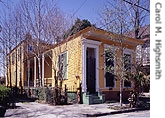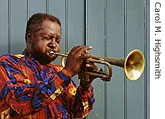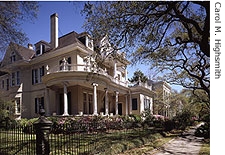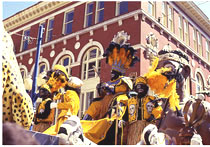| Destruction of a Beloved City Strikes Chord Far Beyond Louisiana |
Washington, D.C.
07 September 2005
|
|
Landphair Report-Download MP3 (1,606 KB) - Download (MP3)
 Landphair Report-Download MP3 (1,606 KB)
- Listen (MP3)
Landphair Report-Download MP3 (1,606 KB)
- Listen (MP3)
 Landphair Report-Download RealAudio (1,064 KB) - Download (Real)
Landphair Report-Download RealAudio (1,064 KB) - Download (Real)
 Landphair Report-Download RealAudio (1,064 KB)
- Listen (Real)
Landphair Report-Download RealAudio (1,064 KB)
- Listen (Real)

 |
| Typical New Orleans "Grand Balconies" of wrought iron | The devastation wrought on the U.S. Gulf Coast by Hurricane Katrina, and the resulting evacuations that are unprecedented in any storm, earthquake, drought, or war on American soil, have horrified and saddened the nation. The ruination of New Orleans, in particular, tears at the hearts of the millions of Americans who have a special fondness for that once-zestful, romantic Louisiana city.
 |
| Old New Orleans graveyard | The old seaport of New Orleans -- founded precariously about three centuries ago by the French on a sliver of dry ground in a mosquito-infested Mississippi River marsh -- had already shouldered its share of sorrows well before Katrina: yellow fever and cholera epidemics so severe that bodies were stacked in above-ground "cities of the dead"; other hurricanes and floods; termite infestations; slave auctions on Jackson Square; terrible fires in the teeming French Quarter.
 |
| A New Orleans "shotgun" cottage | The decaying old city, grown economically reliant on tourism and little else, has steadily lost population over the past 40 years. Its stately mansions and "shotgun" cottages, great cathedrals and nonpareil restaurants, courtyard gardens and vintage streetcars, great oaks and swaying palms were the last, vivid remnants of her wealthy past, when sugar money and then oil money made New Orleans unique -- the undisputed, unforgettable Queen City of the South.
That is, until Katrina left it nearly empty, in pieces, half-sunk beneath foul waters.
Mary Herczog, who lives in the Los Angeles area but owns a home in New Orleans, has written tourist guides to several U.S. cities -- none, she says, with the affection with which she wrote Frommer's Guide to New Orleans.
 |
| Musicians "Jammin'" in New Orleans | "There is more to New Orleans than just the visual," Ms. Herczog says. "The river wind will remain. And as long as there are people there, there will be people who love food and want to make it. And there will be music. And that will be as good as ever -- perhaps even better, thanks to an extra layer of sorrow and celebration, which will give it a resonance like never before. And the people of the town have been and will remain storytellers. And now they have more stories than ever of tragedies and horror, of survival and feats of derring-do, and -- knowing those people -- even some humor. That's what makes up the spirit of New Orleans. And that is not destroyed forever."
 |
| "Jazzman" New Orleans style | Mary Herczog says that the spirit of New Orleans was reflected, for her, in the free music played by brass bands during one of New Orleans' many street festivals, called "Satchmo-Fest," named for the legendary New Orleans jazzman Louis "Satchmo" Armstrong. He was one of many New Orleans artists to sing the "Saint James Infirmary Blues," a mournful song that seems so appropriate in these times:
"I went down to Saint James Infirmary.
Saw my baby there.
Stretched out on a long, white table.
So sweet, so cold, so bare."
 |
| "Uptown" New Orleans | Like Mary Herczog, Randolph Delehanty is a writer, also based in San Francisco. But he wrote a book whose title captured the essence of old New Orleans. It is titled Elegance and Decadence. Mr. Delehanty says there's more than architectural rebuilding ahead for South Louisiana. "I feel like a veil has been removed, and we are seeing the unfortunate and tragic consequences of a deeply split society of haves and have-nots," he says. "Those with resources and options left the city. And those who had no choices remained behind. It's unfair and tragic, and it has resulted in the collapse of civilization. It is a social catastrophe, and it breaks my heart. It's the society that needs reform. We need to rebuild from the heart out."
 |
| New Orleans Mardi Gras Parade (Courtesy Carol M. Highsmith) | In the 1980s Frederick Starr, who was then a vice president and professor of architecture at Tulane University in New Orleans, captured the flavor of the city in a book of vignettes called New Orleans Unmasqued. He is one of thousands who own a home, the fate of which is uncertain, in a place that was once -- though perhaps never will be again -- known as the City that Care Forgot. Mr. Starr says that New Orleans absorbed many cultures -- from French and Spanish and Sicilian, to that of black slaves and Caribbean freedmen -- and took the lighthearted parts of all of them and produced the city's unbridled Carnival, which culminates each year on a Spring Tuesday called "Mardi Gras." And in the heat, he says, New Orleans grew indolent, self-indulgent -- some say overly alcoholic -- with a sense of fatalism about the fragility of life and the capriciousness of nature.
"I know that we're going to be subject to the same vagaries in the future," says Mr. Starr, who maintained a home in New Orleans that he believes was almost certainly destroyed. "I intend to rebuild, and I think you'll find tens of thousands of New Orleanians, thanks to their fatalism, will go back and will do more than any other population would to bring some kind of continuity out of this extreme disorder and discontinuity."
 |
| New Orleans Mardi Gras mask | Frederick Starr says he believes New Orleans will be rebuilt, though he worries that developers will move in and level poor neighborhoods, destroying the city's character and replacing it with what his book calls the "Houstonization" of New Orleans. Clearly, there won't be a jazz festival, or open restaurants, or school classes, or sporting events in New Orleans any time soon. With so many lives and homes lost, could there possibly be a Mardi Gras next spring? And indeed, if the good times can't roll, could there really BE a New Orleans?
 E-mail This Article
E-mail This Article
 Print Version
Print Version
|

